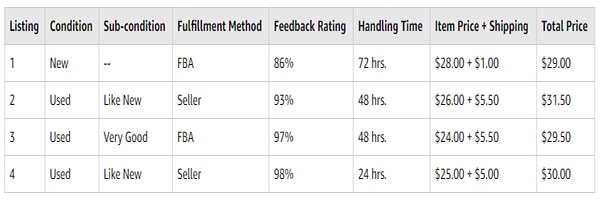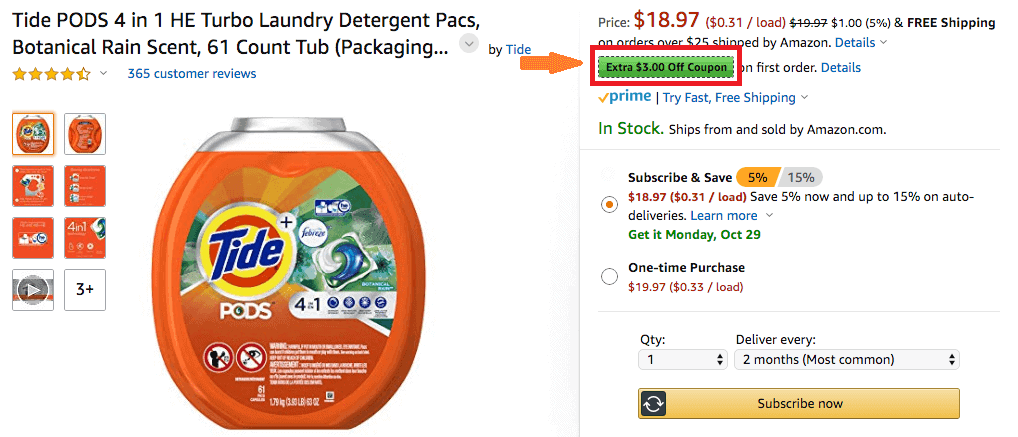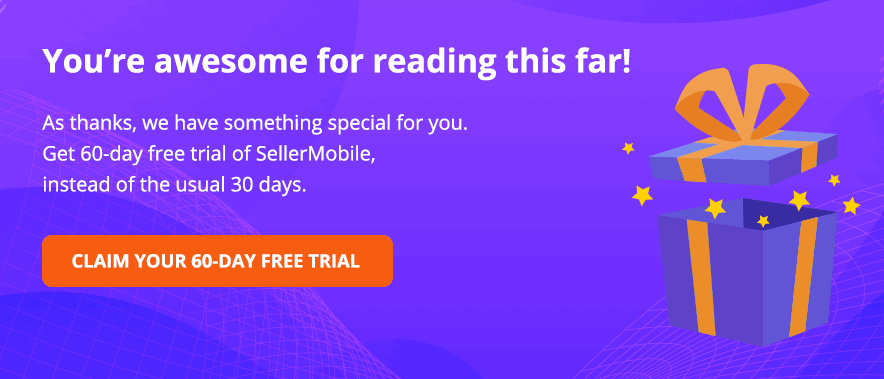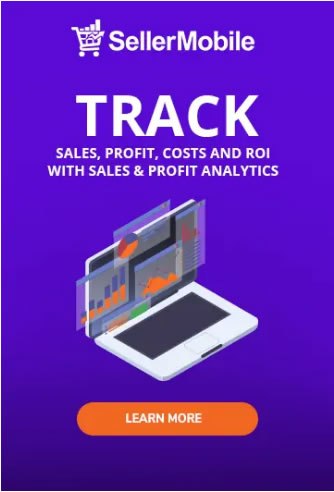Amazon is a very price-sensitive marketplace, which means you need smart pricing strategies to help you earn a decent profit without struggling. Pricing your products wisely could also mean significantly raising your ranking and conversions.
When creating prices for your items, ask yourself these questions. How can your product gain a competitive edge? How do you increase your prices without turning off customers? And how can you persuade customers to put your product in their shopping cart and proceed to checkout?
In this blog, we put together 10 Amazon pricing strategies that use psychology to make your products stand out among the competition.
#1: Set your prices for Page One on Amazon
Technically, you need to consider only two variables when pricing your product on Amazon.
- The lowest price so you can make a profit
- The highest price possible so you can maximize profits
Finding your lowest price
Before setting the price, you need to write down all of your costs. These include:
- Shipping
- Customs
- Payment Wiring
- Amazon Seller Account Fees
- Amazon FBA Fees
- Amazon Referral Fees
- Amazon Variable Closing Fees
- Customer Return Fees (On all returns, Amazon keeps 20% of the original commission as a return fee)
- Your own returns-related fees (return shipping, disposal and product write-offs fees)
- Variable overhead allocation costs
Then, decide what prices would make your item profitable with all the fees included. This will help you determine your Amazon floor price. After that, check how competitive your price is based on the most important search terms for your listing. This is to ensure that your product lands on the first page of Amazon search results.
According to Amazon’s own data, 75% of users never scroll past the first page of search results and 35% of Amazon shoppers click on the first product features on a search page.
Finding your highest price
It is one story to get your listings to page one with exorbitant marketing, and it is entirely another story to keep your position on page one without losing profitability. If you want your listing to stay on page one, take into account your competitors. To do that, you have to look for the top three keywords for your product and study the pricing of the results on page one.
Then, look at your products and assess whether they are reasonably priced. It is safe to price your product 20% more than the highest price you find on page one. For example, if the highest price is $100, your upper price floor should be $120. If you go beyond that, you will struggle landing the top of Amazon search results.
#2: Keep Your Competitors in Mind
In connection with the first tip, a competitive pricing strategy is crucial for pricing analysis. This means you use your competitors’ prices as a benchmark when setting your own prices. When done properly, competitive pricing strategy can improve your sales, your relationship with your suppliers and your profitability.
As per research, 81% of shoppers compare prices of several stores before making a purchase. The higher the item price, the more likely buyers were to research costs online. Many of them compare prices to those listed on Amazon, websites and more.
It is hard to keep tabs on your competitors if you don’t know who they really are. Basically, you have 3 types of competition.
Primary – these are your direct competitors; you target exactly the same audience and sell a similar product. These are the businesses you should keep an eye on.
Secondary – these competitors may offer a high- or low- end version of your product. They may also target a similar audience but sell an entirely different product.
Tertiary – these businesses offer products that are tangentially related to yours but may not be your direct competition just yet. For example, if you sell jewellery, a tertiary competitor may sell gems and stones.
Once you have identified your competitors, it is time to monitor their prices. We believe that using an algorithmic repricer is the best way to make the process less time-consuming and stressful. Machine-based pricing tools have significant benefits over manual approaches since they deliver accurate results in real-time and can process large amounts of complex data as well as provide precise pricing recommendations.
Here’s a sample screenshot of SellerMobile’s Repricer tool summary page. This gives you a quick glance of your repricing data by category, brand, channel and time.
#3: Set Price ABOVE the Lowest FBA Seller
In line with the previous strategy, pricing competitively doesn’t automatically mean you have to set the cheapest price for your items. It is always smart to study your competitors before you decide on your prices.
Creating your prices 1.5% above the lowest FBA seller is one of the best ways to prevent a race-to-the-bottom pricing and maximize the value you receive for every product.
Here’s an example to show how this pricing works.
If I were to sell an ABC123 toy car and the current lowest FBA seller is priced at $10 at the time of this writing, I would set my price at 10.15, which is 1.5% above the lowest FBA seller.
By following this pricing strategy, your sales will keep coming without losing your item’s value.
#4: Use Amazon’s Match Low Price Feature
As an Amazon seller, you have the opportunity to take advantage of Amazon’s Match Low Price filter in your Seller Central account. This feature enables you to quickly and easily match the current lowest prices of similar items you are selling in the Amazon Marketplace, thus allowing you to set a competitive price based on the other prices within the market.
The Match Low Price feature helps merchants compare offers using the following variations:
- Listing condition
- Fulfillment method
- Feedback rating
- Handling time
Here’s a good example on how Match Low Price works, as illustrated by Amazon:
You have a listing for a product that is in “Used-Like New” condition. The listing is seller-fulfilled for a price of $26.00 + $5.50 shipping (Listing 2 in the chart below). Your Customer Feedback rating is 93%, and your handling time is 48 hours. There are three other listings on Amazon for the same product. Referring to the chart below, the current lowest price would be selected as follows:
- Listing 1 ($29.00): Displays if your Low Price Comparison preferences are set to compare offers in all conditions, all fulfillment methods, any feedback rating, and all handling times.
- Listing 3 ($29.50): Displays if your Low Price Comparison preferences are set to compare offers in the same condition, all fulfillment methods, any feedback rating, and similar handling times.
- Listing 4 ($30.00): Displays if your Low Price Comparison preferences are set to compare offers in the same sub-condition and same fulfillment method, with the same or higher feedback rating, and same or faster handling time.

#5: Consider Different Times of the Year
Most seasoned Amazon sellers already know when and which of their stock sell at higher margins in a year. If you are just starting out on Amazon, a perfect time to increase your price without driving customers away is during the fourth quarter. This is because shoppers pay less attention to prices during the holidays, and will simply get the item they want before it gets out of stock.
Using an algorithmic repricing tool will allow you to set up and automate your repricing strategy (as often as necessary) for those times of the year. Prices change really fast on Amazon, and during Q4 they change as quickly as ten times or more in an hour. If you had to do it manually, you would fail to look after other functions of your business and everything would suffer overall as a result. With an advanced repricing tool, the algorithm will do all the work for you in real-time so you can focus on other areas.
#6: Take Advantage of Amazon’s Maximum Price
Amazon allows a maximum selling price of $300,000 for a single product. The price may vary depending on where you live. Sure, selling an item as expensive as this doesn’t make any sense, but this Amazon pricing strategy may work for you.
Here’s how…
First, you have to talk with your manufacturer and ask them to revamp your product to make it ultimately unique. Next, buy a sample of that item, ship it to an Amazon’s fulfillment centre, and then list it for $250,000 or $300,000.
You will get so much advantage from this listing because the traffic will come. Now, you might be wondering how’s that possible. Well, there are countless blog posts and news articles that feature expensive things on Amazon and similar round-ups – and those posts keep popping up. Who knows your product could be featured in one of those posts.
Curious readers will drop by your page and see your product. They may not buy it, but capturing and driving external traffic to your Amazon listing is a great way to get a leg up over your competition and raise your ranking.
#7: Provide a Price and Product that Delivers Value
If your item brings a benefit to the table that your competition does not offer, buyers will be willing to pay a higher price for your item since they feel like they are getting more value from it.
In fact, research suggests that price and quality are the top considerations when consumers make a purchase. This means that by offering a higher price along with unique features show your customers that what you are selling is high-quality. Factors such as comfort, fit, convenience and customer service act as secondary drivers.
If you are selling something very similar to your competition, you will need to price your products lower in order to drive sales, which in turn, can eat into your profit margins. If you also keep slashing prices to match the competition you will end up playing the “price war” game. Over time, this will drive down the perceived value of your product and your brand despite having a healthy inventory. It may not be a fair label, but consumers have an innate tendency to associate cheap prices with cheap products.
Depending on what you are selling, deliberate over the type of features that will motivate customers to pick your item over the competition. Is your target buyer focused on something that works well or is simply looking for a product that looks good? Have you observed a common issue in the review section of your competitors that you can fix and include in your product design? If you can’t put your finger on your customer’s problem, offering a product that can solve it will prove challenging. On the other hand, the more solutions your product can offer, the easier time you will have justifying a higher price and the more inclined buyers to spend money for it.
#8: Keep Your Prices Flexible
Consider “dynamic pricing”, a pricing strategy where the price of a product shifts based on the current market conditions and different factors. You might change your product’s price based on supply and demand, customer behavior, competitor pricing, or even the time of day and weather conditions. While this isn’t a brand new pricing strategy, it is currently making waves in eCommerce. In fact, Amazon is one of the largest retailers to have adopted dynamic pricing and updates prices every 10 minutes.
So how does it work? Dynamic pricing strategy gives retailers the flexibility to decrease prices to increase sales when they are sluggish and increase prices to generate more profit when they are booming.
There are huge benefits of using dynamic pricing. You will gain access to real-time price trends across thousands of products within your niche. You will see price changes of your competitors and get additional insights on market trends. You can launch seasonal and promotional offers while still remaining profitable.
Here’s where a pricing intelligence software plays its role again. It will scan thousands of products every 10 minutes, sparing you from manually tracking competitors.
Here are the top dynamic pricing tactics you can apply on your Amazon store:
- Time-based pricing: It lets you adjust prices according to the time of day or how long a product has been on the market. Got old stock? Instead of letting them collect dust on the shelves, mark their prices down so you can increase demand.
- Penetration pricing: Launching a new item? This pricing strategy allows you to set a lower price than most of your competition so you can persuade shoppers to buy your product.
- Segmented pricing: This is where you offer the same product or services but at different (or unique) prices to different types of customers. For example, Apple iPhone fluctuates its prices according to how much memory each item holds.
- Peak pricing: This pricing depends on the current supply. Increase your prices when demand is high or when competitors have low inventory. The holiday seasons offers the best time to try this pricing strategy.
#9: Optimize Your Amazon Listings
Knowing how to optimize your listings is one of the most important Amazon pricing strategies. As an Amazon seller, you need to ensure that your potential customers actually see your product so they can decide to buy it.
For most shoppers, their buying journey on Amazon starts at the search bar. They type in key phrases and Amazon shows items that are good matches to the customer’s query. Ranking high on Amazon’s search results makes it more likely for customers to click on your listing and less likely on your competitors. As said above, majority of successful purchases happen on page one of organic search.
Besides displaying the top-selling and relevant products, Amazon also checks if the product has been aptly priced and how well optimized the listing is. Choose your terms very carefully, and collect as many as possible to increase the likelihood of your product being found in searches.
Here are a few elements in your listing, which play a big part in determining your conversions and sales success:
- Product Image – Use high-quality photos with zoom feature
- Product Title – Incorporate relevant keywords to improve your chances of showing up in search results
- Product Features – Highlight the most important features of your product using clear, concise points. Include keywords too.
- Product Description – Expand your product features, benefits and unique characteristics. Use as many keywords as possible.
- Product Ratings – Increase average star rating by providing stellar customer experience
- Product Reviews – Earn more positive feedback while minimizing negative reviews.
In a separate blog post, we put together 5 simple ways to optimize your Amazon listing. By applying strong optimization practices, you can increase the discoverability and potential sales of your product.
#10: Include Coupons in Your Pricing Strategy
Coupons could be a huge deal. It offers greater visibility and powerful targeting options that could boost your click through rate, improve your sales, and ultimately set you apart from the competition. They can be used simultaneously with other promotions (Lightning Deal etc.) or offered exclusively to desired customers (only to Prime members). They are also flexible and can be extended up to 90 days, depending on your budget and the availability of your stock.
The only requirement for setting up your Coupons promotion is that you need to be professional seller with a store rating of 3.5 and above. But before you create coupons yourself, know Amazon coupon terms and conditions first. You can use Amazon coupons on your top sellers, your under-performers, and everything in-between.
When you apply a coupon to one of your products, the coupon shows up on the product detail page, in search results, on the Gold Box Deals page, as well as on a separate dedicated landing page just for coupons.
[insert image of products with coupons on Amazon]
There are two types of coupons you can offer to your audience -Percentage Off and Discount Amounts. Most shoppers prefer the latter since it only requires little math, unlike with percentage off where calculations can get a bit more complicated.

We highly suggest that you try out different coupon discounts for different products and assess which amounts yield more sales. This way you can hone in on the exact discount price that maximizes your conversion gain from coupons.
Note: Every time someone clicks on a coupon, Amazon charges 60 cents, so you’ll want to add this into your profit margin calculations.
And that’s it! Stay tuned for the next 10 Amazon pricing strategies that will help take your product sales to the next level, give you more Buy Box wins, raise your rankings, and improve your profit margin.
In the meantime, if you need help with your pricing strategies or want to learn more about our Repricer Tool, feel free to contact us.






